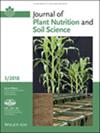Synthesis, characterization and evaluation of novel manganese nanoclay polymer composite and nano-MnO2 in wheat
Abstract
Background
Manganese (Mn) deficiency due to nutrient mining by high yielding cereal–cereal cropping patterns and forgetfulness of Mn fertilizer applications becomes potential challenge in crop production.
Aim
Nano-enabled Mn fertilizers can be safer and more nutrient efficient than conventional Mn fertilizers (nutrient use efficiency ≈ 1%–3%). However, studies about nano-Mn fertilizer synthesis and their behaviour in soil–plant system are rare.
Methods
In this study, two novel nano-Mn fertilizers, that is nano-MnO2 (NMO) and manganese nanoclay polymer composites (Mn-NCPC), were synthesized, characterized (dynamic light scattering, X-ray diffraction, Scanning electron microscopic and energy-dispersive X-ray, Fourier transform infrared spectroscopy etc.) and investigated for their impact on growth, yield and nutrient acquisition by wheat crop (Triticum aestivum L., variety HD-2967) in a pot culture experiment. Treatment comprised 25%, 50% and 100% of recommended dose of Mn (RDMn) through NMO along with 100% RDMn through MnSO4·H2O (MS). Effect of exposure route was also investigated using foliar spray of NMO at tillering stage. Mn-NCPC was found to be most efficient Mn fertilizer in terms of yield, Mn uptake and use efficiency by wheat crop.
Results
Nano-sized formulations improved the solubility of Mn in soil due to its higher active surface area (NMO) and slow-release behaviour (Mn-NCPC); thus, minimal losses happened due to the fixing of Mn in oxide/hydroxide forms. Application of 25% RDMn through NMO fertilizers maintained equitant diethylenetriamine pentaacetate Mn content to 100% RDMn through MnSO4·H2O. Mn-NCPC stimulated the soil enzymatic activities, namely dehydrogenase, acid–alkaline phosphatase activities. Mn-NCPC and NMO at 100% RDMn recorded 3.51% and 5.20% improvement in grain yield, respectively, when compared to MnSO4·H2O 100%.
Conclusions
Mn fertilizer doses can be reduced up to 25% of RDMn when applied through NMO or Mn-NCPC fertilizers. However, effects of Mn-NCPC and NMO need to be critically evaluated in long-term field experiments in various cropping systems especially under cereal–cereal sequences for economic profitability and wide-scale farmer's adaptability.

 求助内容:
求助内容: 应助结果提醒方式:
应助结果提醒方式:


